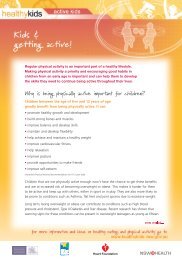I Move We Move - Good For Kids - NSW Government
I Move We Move - Good For Kids - NSW Government
I Move We Move - Good For Kids - NSW Government
You also want an ePaper? Increase the reach of your titles
YUMPU automatically turns print PDFs into web optimized ePapers that Google loves.
A description of the three developmental periods and broadly what movement skills are important<br />
to develop in each period is provided below:<br />
1. Babies (birth to 12 months)<br />
Appropriate developmental movement helps babies to develop their muscles, inner ear and eyes<br />
in preparation for developing fundamental movement skills. This includes tummy time, where<br />
activities such as reaching for objects, turning of head or rolling toward a stimulus and movement<br />
of the arms and legs are encouraged16 .<br />
Development of locomotor skills occurs from about six months of age. These include crawling,<br />
using an object to pull themselves up to a standing position then continuing to use the object to<br />
support moving in an upright position, and finally walking 16 .<br />
2. Toddlers (one to three years old)<br />
Appropriate fundamental movement skills for toddlers to explore are:<br />
• Stability – balancing, bending, stretching<br />
• Locomotor – crawling and walking then run, jump, hop and gallop<br />
• Manipulative – catching, throwing and kicking<br />
Once children are walking well, development of other locomotor skills can be encouraged as well<br />
as stability and manipulative skills 16 . Children under two years of age are unlikely to have the handeye<br />
and foot-eye co-ordination required for manipulative skills, but encouraging experimentation<br />
will develop this co-ordination 15 . Nor will children less than two and a half to three years of age be<br />
likely to have an awareness of their preferred hand and foot for catching, throwing and kicking<br />
etc 15 . So, when encouraging toddlers to attempt catching, throwing and kicking it is important to<br />
let them choose which hand or foot to try first and then encourage them to have another go using<br />
the other hand or foot.<br />
Did you know?<br />
The awareness of preferred<br />
hand and foot, and hand-eye<br />
co-ordination developed through<br />
experimenting with manipulative<br />
skills is also important for other<br />
skills like reading and writing<br />
where there needs to be<br />
co-ordination of the child’s<br />
preferred hand and eye 15 .<br />
I <strong>Move</strong> <strong>We</strong> <strong>Move</strong>, The Guide Edition 1 August 2009<br />
AREA HEALTH SERVICE<br />
5.4




